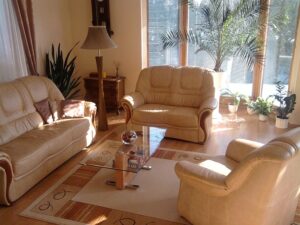Introduction
Dog gland smell on furniture can be an unpleasant and persistent issue for pet owners. The distinct odor is often caused by the anal glands of dogs, which can release a strong scent when they become impacted or infected. If left untreated, this smell can permeate furniture and leave an unwelcome aroma in your home. In this article, we will explore effective methods to get rid of dog gland smell on furniture and restore freshness to your living space.
Cleaning the Furniture
Vacuuming: Start by thoroughly vacuuming the affected furniture to remove any loose hair, dander, or debris. Use a vacuum cleaner with a brush attachment to ensure effective cleaning.
Spot Cleaning: For localized areas with dog gland smell, spot cleaning can be effective. Mix a solution of mild dish soap and warm water. Dampen a clean cloth or sponge with the solution and gently blot the affected area. Avoid rubbing, as it may spread the odor further into the fabric.
Enzyme-Based Cleaners: Enzyme-based cleaners are specifically designed to break down organic compounds, including the odor-causing molecules in dog gland secretions. Look for a pet-specific enzymatic cleaner and follow the instructions on the label. Apply the cleaner to the affected area and allow it to sit for the recommended time before blotting it away with a clean cloth.
Deodorizing the Furniture
Baking Soda: Baking soda is a natural deodorizer that can help absorb and neutralize odors. Sprinkle a generous amount of baking soda over the affected area and gently rub it into the fabric. Let it sit for a few hours or overnight, then vacuum it up. Repeat this process if necessary.
Vinegar Solution: Vinegar is another effective natural deodorizer. Mix equal parts white vinegar and water in a spray bottle. Spray the solution onto the affected area and let it sit for a few minutes. Blot the area with a clean cloth to remove the vinegar solution and the odor. Ensure that the fabric is colorfast and won’t be damaged by vinegar before using this method.
Activated Charcoal: Activated charcoal is known for its ability to absorb odors. Place a few charcoal briquettes or activated charcoal sachets near the affected furniture. Leave them in place for a few days to absorb the odor. Remember to keep them out of reach of pets and children.
Preventing Future Odors
Regular Gland Expression: Regularly expressing your dog’s anal glands can help prevent them from becoming impacted or infected, reducing the chances of odor recurrence. Consult your veterinarian or a professional groomer for guidance on how to safely express your dog’s anal glands.
Protective Covers: Consider using protective covers for your furniture, especially if your dog frequently lounges on it. These covers can be easily removed and washed, preventing the odor from seeping into the fabric.
Frequent Cleaning: Regularly clean your furniture to prevent any buildup of dog gland secretions. Vacuuming, spot cleaning, and using deodorizing methods mentioned above can help maintain a fresh-smelling environment.
Conclusion
Removing dog gland smell from furniture requires a combination of cleaning and deodorizing methods. Vacuuming, spot cleaning, and using enzyme-based cleaners can effectively eliminate the odor-causing molecules. Deodorizing with baking soda, vinegar solutions, or activated charcoal can further neutralize any remaining smells. To prevent future odors, consider regular gland expression for your dog and use protective covers for your furniture. With these techniques, you can enjoy a fresh and odor-free living space.
References
– PetMD: www.petmd.com
– The Spruce Pets: www.thesprucepets.com
– American Kennel Club: www.akc.org













